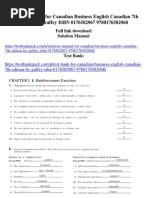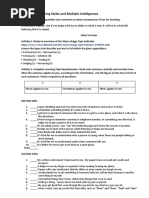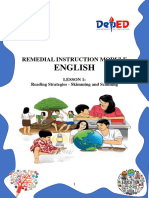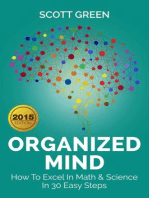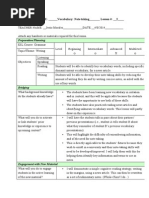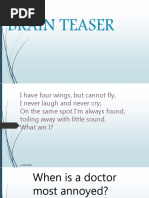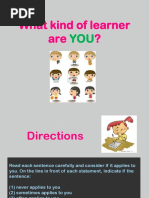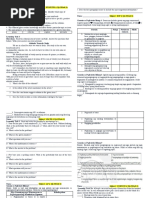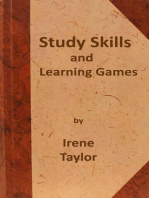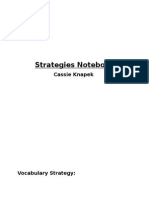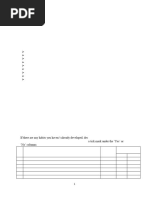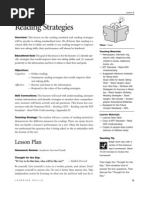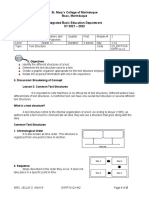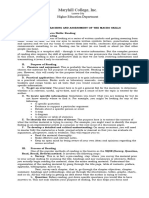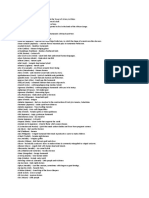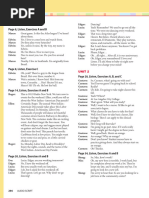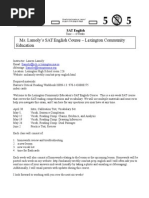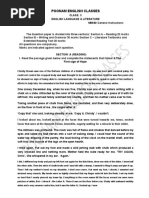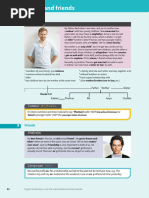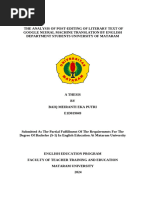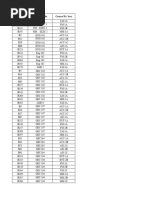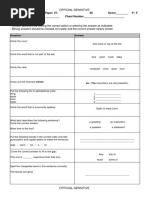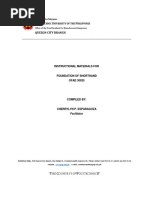1ros_unit2_reading
1ros_unit2_reading
Uploaded by
Lesly Vallejos barraCopyright:
Available Formats
1ros_unit2_reading
1ros_unit2_reading
Uploaded by
Lesly Vallejos barraCopyright
Available Formats
Share this document
Did you find this document useful?
Is this content inappropriate?
Copyright:
Available Formats
1ros_unit2_reading
1ros_unit2_reading
Uploaded by
Lesly Vallejos barraCopyright:
Available Formats
Worksheet: Reading skills
Unit 2 Education and lifelong learning
Subject English Grade 1ºA-1ºB
Teacher Lesly Vallejos Barra Date:
Student’s name
Aim • Demonstrate comprehension of general and specific information from a text.
Instructions • Read carefully this worksheet according to the instructions to your teacher.
• Work individually o with your classmate according to the instructions of your teacher.
• Don’t use your mobile phone
I. Read this text and answer the questions.
Tips to Improve Your Learning
Study Tip 1:_________________________________
It is one of the simplest and best known study tips. It’s easy to
highlight the most significant parts of what you’re reading while
omitting the irrelevant ones. You should use a highlighter to identify
the irreplaceable aspects only after you read for the second time and
mark only one key sentence per paragraph and a few important
phrases here and there.
Study Tip 2:_________________________________
Essentially the aim of note-taking is to summarize lectures or
articles in your own words so that you can easily remember the
ideas. In most cases, the key is to summarize the content as quickly
as possible while not leaving out any key information.
Study Tip 3:_________________________________
A good mind map can save you many hours of study and organize
information for your exams.
Mind maps can be used for brainstorming, writing essays or study
topics and for general
exam preparation.
Study Tip 4:_________________________________
Using picture cards or flashcards is a particularly effective method of
learning when trying to assimilate different facts, dates, formulas or
vocabulary. Subjects such as History, Physics, Chemistry and
Geography are made much easier if you incorporate flashcards.
Picture cards are a good way to learn new vocabulary.
Study Tip 5:_________________________________
This is another study technique that is ideal for studying in groups.
Brainstorming is a great way to expand every possible idea out of
any topic. Just get a bunch of friends together. There are no wrong
answers when brainstorming - just talk and capture the ideas; you
can review afterward.
Study Tip 6:_________________________________
Organizing your study is one of the most effective study skills and, ironically also one of the most often
overlooked. Creating a study timetable gives you goals, ends
irresponsibility and sets the time in which to study. Having a
study timetable as you study is greatly motivational.
In short, we can use any of the above techniques to help make
our study process more effective and easier. You can choose any
of them depending on the type of result you want to achieve.
There are no right or wrong study techniques – you just select
the one that is the most adequate for your purpose. Some of
them are better to study sets and lists, others help us organize
our habits better, while others simply provide us with the
correct ideas.
I. Look at the pictures that illustrate these tips and choose one title for each tip. Then, read the article and
confirm or correct your ideas. (There is one extra title you do not need to use).
a. A rainfall of ideas
b. Only what’s important
c. A good order of ideas
d. Associating concepts
e. Making your own study notes
f. Using images
g. Getting into the habit
II. Choose the best alternative for each question.
1. What is the purpose of the text?
a. To warn.
b. To criticize.
c. To instruct.
d. To describe.
2. In which tip (1 - 6) can you find a reference to...
a. ________using a highlighter?
b. ________summarizing key ideas?
c. ________the technique being a good tool for language study?
d. ________organizing information for exams?
II. Answer these questions.
1.How would you apply any of the ideas to your studies and / or life?
________________________________________________________________________________________
2.What other ways to improve the learning process in English would you use?
________________________________________________________________________________________
3.How can you apply this information in everyday life?
________________________________________________________________________________________
4.Think of a situation where you had to learn something very fast. Did you use a special technique to help you?
Which one? Was it useful?
________________________________________________________________________________________
III. Do the following quiz and find your learning style. Then, share your results in your group and
comment on them. Circle the best answer for each question.
1. If I have to learn how to do something, I learn best when I:
a. watch someone to show me how.
b. hear someone tell me how.
c. try to do it myself.
2. When I spell, I verify accuracy by:
a. looking at the word to see if it looks correct.
b. sounding the word out in my head.
c. getting a feeling about the correctness of the spelling.
3. When asked to give directions, I:
a. see the actual places in my mind as I say them or prefer to draw them.
b. have no difficulty giving them verbally.
c. have to point or move my body as I give them.
4. When I have to remember a list of items, I remember them best if I:
a. write them down.
b. repeat them over and over to myself.
c. move around and use my fingers to name each item.
5. When solving a problem, I:
a. write or draw diagrams to see it.
b. talk myself through it.
c. use and/or move objects to help me think.
6. When I am adding numbers, I verify my answer by:
a. looking at the numbers to see if they are correct.
b. counting the numbers in my head or out loud.
c. using my fingers to get a feeling if it is correct.
7. When trying to recall names, I remember:
a. Faces more easily than names.
b. Names more easily than faces.
c. The situation or the meeting more easily than names or faces.
8. Before going to sleep at night, I appreciate that:
a. The room is dark.
b. The room is quiet.
c. The bed feels comfortable
RESULTS.
Write in how many of your answers was each of the following letter choices:
a: ____________________________b:________________________ c:_____________________
Interpretation:
If you had mostly a’s, then you are a visual learner.
• Sit in the front of the class or meeting so you can see everything.
• Sketch course content. Even the simplest sketch can help you remember ideas.
• List your tasks – even the ones you have completed – just to have the satisfaction of visually crossing out
tasks done.
• Write notes on your favorite colored sticky-notes to help you remember and paste them around your room.
• A tidy desk may help in clearing your mind to be able to study better.
• Write yourself encouraging notes and post them where you can see them.
• Create mind maps, flowcharts, or other graphic organizers.
If you had mostly b’s, then you are an auditory learner.
• Record the class session and listen to it later for reference and repetition. It may also help if you listen
to it casually while walking to class or before falling asleep.
• Read your textbook and notes aloud as you study. You could even record them as you do so.
• Teach yourself to read aloud in your mind without making sound. During exams, you can hear the test
questions as well as see them.
• Study with a partner or in a group. When studying with others, you can hear what they say, and hear yourself
teaching them as well. This will reinforce your understanding of the material.
• Proofread your assignments out loud.
If you had mostly c’s, then you are a kinesthetic learner.
• Sit where you can actively participate in classroom events and discussions.
• Take notes creatively. For instance, draw quick pictures in class that relates to the material
being taught.
• Ask and answer questions before, during, and after class.
• Make models of the concepts whenever possible.
• Move around while you are studying. For instance, you can simply walk around in your room.
• Study on a whiteboard. Draw flowcharts, mind maps, or simply rewrite the notes.
• Incorporate pictures of models, if possible.
• Make physical comfort a priority as you study.
• Make note cards and create sample tests that you can take for review.
2. Underline three learning tips you found useful in the interpretation section of the quiz. Then, write down
two more tips of your own.
___________________________________________________________________________________________
___________________________________________________________________________________________
___________________________________________________________________________________________
You might also like
- Canadian Business English Canadian 7th Edition by Guffey ISBN Solution ManualDocument13 pagesCanadian Business English Canadian 7th Edition by Guffey ISBN Solution Manualscott100% (32)
- Sylvia Plath Selected PoemsDocument7 pagesSylvia Plath Selected PoemsAlexander RossNo ratings yet
- q3 g11 Practical Research 1 Week 3 Module 9Document18 pagesq3 g11 Practical Research 1 Week 3 Module 9Debbie Grace50% (2)
- Week 2 Readings-Introduction To Paragraphs WritingDocument14 pagesWeek 2 Readings-Introduction To Paragraphs WritingRandy RebmanNo ratings yet
- Color Coding LPDocument4 pagesColor Coding LPapi-310307595No ratings yet
- Comm I Un 123 FinalDocument14 pagesComm I Un 123 FinalBaca MulatuNo ratings yet
- Quarter 1 - Module 1: My Study Habits Version 4.0: Rank Learning Style 1 2 3 4 5Document4 pagesQuarter 1 - Module 1: My Study Habits Version 4.0: Rank Learning Style 1 2 3 4 5phoebecruz636No ratings yet
- Learning Styles SurveyDocument10 pagesLearning Styles SurveySerenaSanchezNo ratings yet
- SQ3R MethodDocument8 pagesSQ3R MethodKhushiNo ratings yet
- Taking Notes Form LecturesDocument43 pagesTaking Notes Form LecturesShirley Gadiano Milla RmiNo ratings yet
- Communicative English Language Skills Unit 1Document13 pagesCommunicative English Language Skills Unit 1Moti GurmessaNo ratings yet
- Cultural Anthropology: Study Strategies Guide To AccompanyDocument20 pagesCultural Anthropology: Study Strategies Guide To AccompanyShumaila KhanNo ratings yet
- LP Grade 7 DKBBDocument5 pagesLP Grade 7 DKBBDimple BolotaoloNo ratings yet
- LP For Reading 1 KathyDocument4 pagesLP For Reading 1 KathyDimple BolotaoloNo ratings yet
- Homeroom Guidance (HG) Quarter 1 - Module 1 Level Up Your Study HabitsDocument4 pagesHomeroom Guidance (HG) Quarter 1 - Module 1 Level Up Your Study HabitsMari PagxNo ratings yet
- ENGLISH 6 Q1 W6 Mod6 Impromptu SpeechDocument11 pagesENGLISH 6 Q1 W6 Mod6 Impromptu Speecherma rose hernandez100% (2)
- Seminar 2 Methods Year 5Document8 pagesSeminar 2 Methods Year 5AlyonaNo ratings yet
- Study HabitsDocument17 pagesStudy HabitsSrihari Managoli100% (4)
- Module 1Document23 pagesModule 1Reika AsuyaNo ratings yet
- Organized Mind : How To Excel In Math & Science In 30 Easy Steps: The Blokehead Success SeriesFrom EverandOrganized Mind : How To Excel In Math & Science In 30 Easy Steps: The Blokehead Success SeriesRating: 4 out of 5 stars4/5 (1)
- Note Taking LPDocument4 pagesNote Taking LPapi-253830865No ratings yet
- EngG8 Q4 Module 3Document12 pagesEngG8 Q4 Module 3Abi Ramirez Ramos-SadangNo ratings yet
- Cabales - Facilitating Learning Prelim - Midterm ModuleDocument19 pagesCabales - Facilitating Learning Prelim - Midterm ModuleApril Love C LambacoNo ratings yet
- Teachingstrategicreading 170126123615 PDFDocument24 pagesTeachingstrategicreading 170126123615 PDFpaula cardenasNo ratings yet
- SPEAKING - Perform Well in Exam and Be A Top StudentDocument44 pagesSPEAKING - Perform Well in Exam and Be A Top Studentnoreen diorNo ratings yet
- What Kind of Learner Are ?Document9 pagesWhat Kind of Learner Are ?Carmen Sanjuan MeléndezNo ratings yet
- All Independent WorkDocument7 pagesAll Independent Workkaiswaggy2No ratings yet
- ENGL 1 Act 1 3rd QMetacognitive StrategiesDocument9 pagesENGL 1 Act 1 3rd QMetacognitive StrategiesClaudia Taneo InocNo ratings yet
- Physical Sciences - Vertical Projectile MotionDocument30 pagesPhysical Sciences - Vertical Projectile Motionson gokuNo ratings yet
- Revitalized Homeroom Guidance Program (RHGP) Grade 7 - Quarter 2 Module 1: My Road To SuccessDocument5 pagesRevitalized Homeroom Guidance Program (RHGP) Grade 7 - Quarter 2 Module 1: My Road To SuccessAngelica PascualNo ratings yet
- Communicative English IDocument67 pagesCommunicative English Imelkam getnetNo ratings yet
- Excel in Studies: Check List: Grade Yourself From 0 To 10 (0 If You Feel You Are Not at All Up To TheDocument3 pagesExcel in Studies: Check List: Grade Yourself From 0 To 10 (0 If You Feel You Are Not at All Up To Thejeravi84No ratings yet
- T10 Class 6 Lesson 2ADocument22 pagesT10 Class 6 Lesson 2Aasly celeste veira lealNo ratings yet
- Activity Sheets Q4 Wk. 8Document8 pagesActivity Sheets Q4 Wk. 8Tine Delas AlasNo ratings yet
- How To Produce Excellent Notes and Use Them To Prepare For ExamsDocument5 pagesHow To Produce Excellent Notes and Use Them To Prepare For Examsapat52No ratings yet
- Chapter 7 Reading To Learn For College StudentsDocument11 pagesChapter 7 Reading To Learn For College StudentsResearchcenter CLTNo ratings yet
- Strategies Notebook RealDocument25 pagesStrategies Notebook Realapi-299487843No ratings yet
- FIELD STUDY 2 (Episode 2)Document5 pagesFIELD STUDY 2 (Episode 2)Jerico Padilla NuestroNo ratings yet
- Facilitating Learning - Module 1 - MetacognitionDocument6 pagesFacilitating Learning - Module 1 - MetacognitionRhys LaciaNo ratings yet
- Home Room Guidance Act.Document17 pagesHome Room Guidance Act.janellabautista48No ratings yet
- Review of Learning and PrepDocument2 pagesReview of Learning and PrepAnonymous gPhRqg3No ratings yet
- Communicative English Ls iDocument48 pagesCommunicative English Ls inaolhurgasaNo ratings yet
- HG Grade 7Document4 pagesHG Grade 7mary ann celisNo ratings yet
- Sample ActivitiesDocument12 pagesSample ActivitiesjovingeorgeNo ratings yet
- LI1 U1 Passage My FamilyDocument22 pagesLI1 U1 Passage My FamilyHeinrich GilbertNo ratings yet
- Reading Strategies: Lesson PlanDocument6 pagesReading Strategies: Lesson PlanТеодора ВласеваNo ratings yet
- English AssignmentsDocument13 pagesEnglish AssignmentsElias BerhanuNo ratings yet
- Curriculum ActivitiesDocument15 pagesCurriculum ActivitiesJerome SabejonNo ratings yet
- Study Skills GuideDocument19 pagesStudy Skills Guidefirdausar08No ratings yet
- St. Mary's College of Marinduque Boac, Marinduque Integrated Basic Education Department SY 2021 - 2022 I. TitleDocument5 pagesSt. Mary's College of Marinduque Boac, Marinduque Integrated Basic Education Department SY 2021 - 2022 I. TitleJellie AnayaNo ratings yet
- مادة اثرائية في اللغة الانجليزية للصف الحادي عشر الفصل الأول علمي + أدبيDocument58 pagesمادة اثرائية في اللغة الانجليزية للصف الحادي عشر الفصل الأول علمي + أدبيmoayad.saramahNo ratings yet
- Active Learning TechiquesDocument2 pagesActive Learning TechiquesEzekielNo ratings yet
- Study Skills: A Group CurriculumDocument20 pagesStudy Skills: A Group Curriculumndaatlanta0% (1)
- ScrolcsiDocument7 pagesScrolcsivjaNo ratings yet
- ReadingDocument4 pagesReadingcharmaine aurinNo ratings yet
- !7-ОШ ФО Англ.яз 6кл 130318Document89 pages!7-ОШ ФО Англ.яз 6кл 130318bbbbbNo ratings yet
- Independent Work IdkDocument9 pagesIndependent Work Idkkaiswaggy2No ratings yet
- Tips Belajar Dengan BetulDocument52 pagesTips Belajar Dengan Betulahmadfadzli hasansaariNo ratings yet
- Studying Tips, Tricks & Hacks: QuickStudy Laminated Reference Guide to Grade Boosting TechniquesFrom EverandStudying Tips, Tricks & Hacks: QuickStudy Laminated Reference Guide to Grade Boosting TechniquesRating: 4.5 out of 5 stars4.5/5 (3)
- Tareas SEMÁNTICADocument10 pagesTareas SEMÁNTICACarlos Osvaldo Lujan AlaveNo ratings yet
- List of CreaturesDocument20 pagesList of Creatureskittehrawr09100% (1)
- SB3 Audio ScriptDocument14 pagesSB3 Audio ScriptThanh ThuyNo ratings yet
- Handout (Poem) - Rain On The Roof - Class IX - 2022-23Document3 pagesHandout (Poem) - Rain On The Roof - Class IX - 2022-23Priya AgrawalNo ratings yet
- Basic Hindi Words For Beginners - Learn Hindi Through EnglishDocument7 pagesBasic Hindi Words For Beginners - Learn Hindi Through EnglishSurbhi Goel50% (2)
- Verbal learningDocument10 pagesVerbal learningJuhi ShrivastavaNo ratings yet
- Sat English SyllabusDocument1 pageSat English Syllabusapi-262637181No ratings yet
- Expressions of Frequency: Once / Twice A Week Three / Four Times A Week / YearDocument1 pageExpressions of Frequency: Once / Twice A Week Three / Four Times A Week / YearJaneth MimNo ratings yet
- Fle4 WB IssuuDocument28 pagesFle4 WB IssuuOllyvian AhabNo ratings yet
- Paper 2Document6 pagesPaper 2imrajeevkabraNo ratings yet
- Family and FriendsDocument2 pagesFamily and FriendsuzunkokbaharNo ratings yet
- Verb PatternsDocument13 pagesVerb Patternssigne.staNo ratings yet
- DESIGNING TASKS FOR THE COMMUNICATIVE CLASSROOM. David Nunan. Cambridge Cambridge University Press, 1989. Pp. X + 211.Document2 pagesDESIGNING TASKS FOR THE COMMUNICATIVE CLASSROOM. David Nunan. Cambridge Cambridge University Press, 1989. Pp. X + 211.Paula RodríguezNo ratings yet
- IAN COT 2021 Be VerbsDocument3 pagesIAN COT 2021 Be VerbsIJ PetalcorinNo ratings yet
- English Stage 5 01 MS 5RP AFP tcm142-640244Document12 pagesEnglish Stage 5 01 MS 5RP AFP tcm142-640244Farida mosaad50% (2)
- Baiq Meira EpDocument57 pagesBaiq Meira EpNurhidayahNo ratings yet
- Figures of Speech: This Photo by Unknown Author Is Licensed Under CC BY-NC-NDDocument30 pagesFigures of Speech: This Photo by Unknown Author Is Licensed Under CC BY-NC-NDDevika SNo ratings yet
- Midterm Exams Wednesday Apr 12 2023Document8 pagesMidterm Exams Wednesday Apr 12 2023Were dooomedNo ratings yet
- Scoring Rubric For Field Study 2 EpisodesDocument2 pagesScoring Rubric For Field Study 2 Episodesbc michellesarahNo ratings yet
- Irreg Vbs ListDocument6 pagesIrreg Vbs ListEnrique GautierNo ratings yet
- AEF 2e Starter B TOEIC BRIDGE TESTDocument30 pagesAEF 2e Starter B TOEIC BRIDGE TESTCHRISTIAN ANDRES AVILA AMAYANo ratings yet
- EN ISO 13680 (2008) (E) CodifiedDocument9 pagesEN ISO 13680 (2008) (E) CodifiedSshg HNo ratings yet
- Iot Systems - Logical Design Using Python: Bahga & Madisetti, © 2015Document31 pagesIot Systems - Logical Design Using Python: Bahga & Madisetti, © 2015BaalaNo ratings yet
- Hena012 Active Vs Passive VoiceDocument18 pagesHena012 Active Vs Passive VoicemaphandamolletNo ratings yet
- English Assignment PaperDocument12 pagesEnglish Assignment PaperWarrior ShortsNo ratings yet
- PTE Answer StructureDocument3 pagesPTE Answer StructureIndika AmarakoonNo ratings yet
- Stanford FLOSEM (Foreign Language Oral Skills Evaluation Matrix) Student's Name & ID Number - DATEDocument2 pagesStanford FLOSEM (Foreign Language Oral Skills Evaluation Matrix) Student's Name & ID Number - DATEEugenia AmpavaNo ratings yet
- P U P Quezon City Branch: Olytechnic Niversity of The HilippinesDocument142 pagesP U P Quezon City Branch: Olytechnic Niversity of The HilippinesMaikaela AcuarioNo ratings yet
